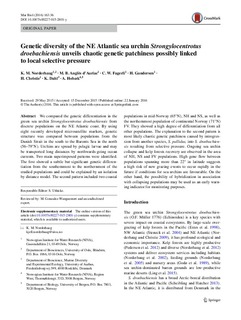| dc.contributor.author | Norderhaug, K. M. | |
| dc.contributor.author | Angles d'Auriac, M. B. | |
| dc.contributor.author | Fagerli, C. W. | |
| dc.contributor.author | Gundersen, H. | |
| dc.contributor.author | Christie, H. | |
| dc.contributor.author | Dahl, K. | |
| dc.contributor.author | Hobæk, A. | |
| dc.date.accessioned | 2018-09-13T11:22:12Z | |
| dc.date.available | 2018-09-13T11:22:12Z | |
| dc.date.created | 2016-07-06T15:46:31Z | |
| dc.date.issued | 2016 | |
| dc.identifier.citation | Marine Biology. 2016, 163 (36), 13. | nb_NO |
| dc.identifier.issn | 0025-3162 | |
| dc.identifier.uri | http://hdl.handle.net/11250/2562497 | |
| dc.description.abstract | We compared the genetic differentiation in the green sea urchin Strongylocentrotus droebachiensis from discrete populations on the NE Atlantic coast. By using eight recently developed microsatellite markers, genetic structure was compared between populations from the Danish Strait in the south to the Barents Sea in the north (56–79°N). Urchins are spread by pelagic larvae and may be transported long distances by northwards-going ocean currents. Two main superimposed patterns were identified. The first showed a subtle but significant genetic differentiation from the southernmost to the northernmost of the studied populations and could be explained by an isolation by distance model. The second pattern included two coastal populations in mid-Norway (65°N), NH and NS, as well as the northernmost population of continental Norway (71°N) FV. They showed a high degree of differentiation from all other populations. The explanation to the second pattern is most likely chaotic genetic patchiness caused by introgression from another species, S. pallidus, into S. droebachiensis resulting from selective pressure. Ongoing sea urchin collapse and kelp forests recovery are observed in the area of NH, NS and FV populations. High gene flow between populations spanning more than 22° in latitude suggests a high risk of new grazing events to occur rapidly in the future if conditions for sea urchins are favourable. On the other hand, the possibility of hybridization in association with collapsing populations may be used as an early warning indicator for monitoring purposes. | nb_NO |
| dc.language.iso | eng | nb_NO |
| dc.publisher | Springer Verlag | nb_NO |
| dc.rights | Navngivelse 4.0 Internasjonal | * |
| dc.rights.uri | http://creativecommons.org/licenses/by/4.0/deed.no | * |
| dc.title | Genetic diversity of the NE Atlantic sea urchin Strongylocentrotus droebachiensis unveils chaotic genetic patchiness possibly linked to local selective pressure | nb_NO |
| dc.title.alternative | Genetic diversity of the NE Atlantic sea urchin Strongylocentrotus droebachiensis unveils chaotic genetic patchiness possibly linked to local selective pressure | nb_NO |
| dc.type | Journal article | nb_NO |
| dc.type | Peer reviewed | nb_NO |
| dc.description.version | publishedVersion | nb_NO |
| dc.rights.holder | © The Author(s) 2016 | nb_NO |
| dc.source.pagenumber | 13 | nb_NO |
| dc.source.volume | 163 | nb_NO |
| dc.source.journal | Marine Biology | nb_NO |
| dc.source.issue | 36 | nb_NO |
| dc.identifier.doi | 10.1007/s00227-015-2801-y | |
| dc.identifier.cristin | 1366588 | |
| dc.relation.project | Norges forskningsråd: 160016 | nb_NO |
| cristin.unitcode | 7464,20,11,0 | |
| cristin.unitcode | 7464,20,15,0 | |
| cristin.unitcode | 7464,30,19,0 | |
| cristin.unitname | Marin biologi | |
| cristin.unitname | Akvakultur | |
| cristin.unitname | Ferskvannsøkologi | |
| cristin.ispublished | true | |
| cristin.fulltext | original | |
| cristin.qualitycode | 1 | |

